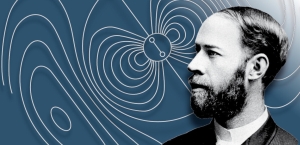Doing mobile phone calls, checking electronic mails while being away, listening to the news in the car: Mobile communication at any time and place is part of our everyday life. It is based on a physical effect discovered by Heinrich Hertz in Karlsruhe in 1886. Hertz presented it to the world in 1888, exactly 125 years ago: The electromagnetic wave.
“Heinrich Hertz was an outstanding researcher of his time,” Professor Holger Hanselka, President of KIT, says. “For his discovery, Hertz interlinked research areas and laid the foundation for a scientific and industrial revolution. In the line of academic ancestors, Heinrich Hertz is a role model that has been influencing generations of researchers in Karlsruhe up to this date.”
On December 04, 2013, a ceremony at KIT will commemorate the discovery made by Hertz. The program will focus on the significance of Hertz for the development of technology at that time and today. On December 13, 1888, 125 years ago, Hertz presented the electromagnetic waves to the Royal Prussian Academy in Berlin under the title “Propagation of Electric Action”. KIT’s ceremony will be open to the public, admission will be free. Representatives of the media are cordially invited.
Ceremony:
“Heinrich Hertz – 125 Years Propagation of Electric Action”
on Wednesday, December 04, 2013, 18 hrs
Tulla-Hörsaal, building 11.40, Englerstraße 11;
KIT Campus South, Karlsruhe, Germany
For the program of the ceremony click: http://www.zak.kit.edu/hertz
“In the late 19th century, the search for electromagnetic waves was about equivalent to today’s search for the Higgs particle, dark matter or the neutrino mass,” Volker Krebs, retired professor at KIT and Chairman of the Heinrich Hertz Society, explains. The problem of fundamental research that was most fervently discussed by the experts was whether electromagnetic waves of finite wavelength exist. “With his measurements, Hertz confirmed the so-called near-effect theory and proved that electromagnetic effects propagate at the speed of light,” Krebs says. “This fundamental finding made 125 years ago is the basis of any mobile phone call and any radio transmission today.” Radio, television, mobile communication, and WLAN have their origin in the discovery made by Hertz.
For several weeks, Hertz conducted his experiments in a lecture hall of the then Technical University, today’s Heinrich Hertz Lecture Hall on KIT Campus South. He used a spark gap transmitter in an oscillating electromagnetic dipole. The receiver was a slotted wire ring, in which he always observed sparks when a spark-over occurred at the transmitter. On November 11, 1886, propagation of an electromagnetic wave was observed experimentally for the first time and Maxwell’s near-effect theory of electrodynamics was confirmed.
In further experiments with mirrors and standing waves, Hertz demonstrated later that he had generated waves with a wavelength of 30 to 100 centimeters and frequencies between 1000 and 300 MHz, respectively. The results of the two years of research in Karlsruhe and in particular the proof of the identity of light and electromagnetic waves were presented for the first time to the Royal Prussian Academy in Berlin and, hence, to the public on December 13, 1888. Hertz became the pioneer of high-frequency and radio technology that was then transferred to application by Guglielmo Marconi, Alexander Popov, and Ferdinand Braun. In the honor of Heinrich Hertz, the unit of frequency, Hertz, Hz, was established.
On the occasion of this year’s anniversary, the Federal Ministry of Finance (BMF) issued a 10-Euro commemorative coin to honor the discovery of electromagnetic waves. The coin shows the spark gap transmitter and the field lines of a Hertzian dipole. The edge of the coin bears the inscription “Licht ist eine elektrische Erscheinung” (light is an electric phenomenon). In addition, the BMF has issued a commemorative stamp “125 Jahre Strahlen elektrischer Kraft - Heinrich Hertz” (125 years propagation of electric action) that also shows the field lines of the Hertzian dipole.
“Karlsruhe was for Hertz the first step in his career,” Dr. Klaus Nippert, Head of the KIT Archive, says. In Karlsruhe, 28-year-old Hertz assumed his first post as ordinary professor between 1885 and 1889. Thus, he disposed of an adequate salary and was able to use the existing physics collection. Hertz’s predecessor in office had been Ferdinand Braun, Nobel Prize winner in 1909 and inventor of the cathode ray tube that was to be used widely as an oscilloscope and TV tube later on. “In Baden, Hertz married the daughter of a colleague and started a family,” Nippert knows. With his wife Elisabeth and his daughter Johanna, Heinrich Hertz left Karlsruhe after four years of work and moved to Bonn having refused appointments to Berlin, Gießen, and America. As early as in 1894, Hertz died at the age of 36 in Bonn from a sepsis. He was buried in Hamburg, his place of birth.
Being “The Research University in the Helmholtz Association”, KIT creates and imparts knowledge for the society and the environment. It is the objective to make significant contributions to the global challenges in the fields of energy, mobility, and information. For this, about 10,000 employees cooperate in a broad range of disciplines in natural sciences, engineering sciences, economics, and the humanities and social sciences. KIT prepares its 22,800 students for responsible tasks in society, industry, and science by offering research-based study programs. Innovation efforts at KIT build a bridge between important scientific findings and their application for the benefit of society, economic prosperity, and the preservation of our natural basis of life. KIT is one of the German universities of excellence.

